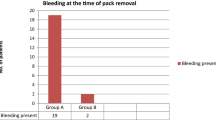Abstract
Nasal packing is the classic method adopted by many otolaryngologists to stabilize the nasal septum and decrease the occurrence of postoperative bleeding and septal hematoma after septoplasty. However, because of its associated postoperative morbidity, many surgeons started to adopt alternative methods. This study aimed to assess the outcome and benefits of septal quilting sutures in comparison to nasal packing after septoplasty. A prospective non-randomized comparative interventional study was carried out at two teaching hospitals in Mosul city from January 2020 to January 2021. A total of 60 patients who were candidates for septoplasty, were included in the study. According to the surgeon's preference; 30 patients had placement of septal quilting sutures (group A), and in the other 30 patients nasal packing was performed (group B). Patients were assessed for postoperative morbidity and early outcome in the first 24 h, 1 week and 1 month postoperatively. In the first 24 h after septoplasty, patients in group B had significantly higher levels of nasal/facial pain, headache, sleep disturbance, breathing difficulties and swallowing difficulties compared to group A (p < 0.001). Over the follow up period of 1 month, no significant differences were recorded regarding postoperative bleeding, hematoma, infection, adhesions formation and septal perforation between the two groups (p > 0.05). Septal quilting sutures technique is more favorable in the early period in terms of patient discomfort after septoplasty, better nasal block and nasal/facial pain, the absence of misery on pack removal, with minimal bleeding after surgery.
Similar content being viewed by others
References
Hsu DW, Suh JD (2018) Anatomy and physiology of nasal obstruction. Otolaryngol Clin NA. https://doi.org/10.1016/j.otc.2018.05.001
Fettman N, Sanford T, Sindwani R (2009) Surgical management of the deviated septum: techniques in septoplasty. Otolaryngol Clin N Am 42:241–252. https://doi.org/10.1016/j.otc.2009.01.005
Bezerra TFP, Stewart MG, Fornazieri MA et al (2012) Quality of life assessment septoplasty in patients with nasal obstruction. Braz J Otorhinolaryngol 78:57–62
Certal V, Silva H, Santos T et al (2012) Trans-septal suturing technique in septoplasty: a systematic review and meta-analysis. Rhinology 50:236–245. https://doi.org/10.4193/Rhino12.051
Wang W-W, Dong B-C (2017) Comparison on effectiveness of trans-septal suturing versus nasal packing after septoplasty: a systematic review and meta-analysis. Eur Arch Oto-Rhino-Laryngology 1. https://doi.org/10.1007/s00405-017-4709-2
Mane RS, Patil B, Mohite A (2013) Comparison of septoplasty with and without nasal packing and review of literature. Indian J Otolaryngol Head Neck Surg 65:406–408. https://doi.org/10.1007/s12070-013-0626-x
Cukurova I, Cetinkaya EA, Mercan GC et al (2012) Retrospective analysis of 697 septoplasty surgery cases: packing versus trans-septal suturing method. Acta Otorhinolaryngol Ital 32:111–114
Korkut AY, Teker AM, Eren SB et al (2010) A randomised prospective trial of trans-septal suturing using a novel device versus nasal packing for septoplasty. Rhinology 48:179–182. https://doi.org/10.4193/Rhin09.098
Dalgic A, Is A, Dinc ME et al (2016) The effects of nasal packing and transseptal suturing after septoplasty on olfactory function, patient comfort, and mucociliary clearance. J Craniofac Surg 27:e487–e490. https://doi.org/10.1097/SCS.0000000000002805
Günaydân RÖ, Aygenc E, Karakullukcu S et al (2011) Nasal packing and transseptal suturing techniques: surgical and anaesthetic perspectives. Eur Arch Otorhinolaryngol 268:1151–1156. https://doi.org/10.1007/s00405-011-1542-x
Dubin MR, Pletcher SD (2009) Postoperative packing after septoplasty: is it necessary? Otolaryngol Clin North Am 42:279–285. https://doi.org/10.1016/j.otc.2009.01.015
Cayonu M, Acar A, Horasanli E et al (2014) Comparison of totally occlusive nasal pack, internal nasal splint, and transseptal suture technique after septoplasty in terms of immediate respiratory distress related to anesthesia and surgical complications. Acta Otolaryngol 134:390–394. https://doi.org/10.3109/00016489.2013.878476
Turhan M, Bostanci A, Akdag M, Dinc O (2013) A comparison of the effects of packing or transseptal suture on polysomnographic parameters in septoplasty. Eur Arch Otorhinolaryngol 270:1339–1344. https://doi.org/10.1007/s00405-012-2199-9
Mustafa Said S, Abdulrazzaq AF (2015) Effect of trans-septal suture technique versus nasal packing after septoplasty. Int J Tech Res Appl 3:33–40
Özkiriş M, Kapusuz Z, Saydam L (2013) Comparison of nasal packs with transseptal suturing after nasal septal surgery. Am J Otolaryngol Head Neck Med Surg 34:308–311
Killera S, Padmanabhan D, Viswanatha B (2018) Nasal septal suture technique versus nasal packing after septoplasty: a prospective comparative study. J Otolaryngol Res 10:1–4. https://doi.org/10.15406/joentr.2018.10.00300
Awan MS, Iqbal M (2008) Nasal packing after septoplasty: a randomized comparison of packing versus no packing in 88 patients. Ear Nose Throat J 87:624–627. https://doi.org/10.1177/014556130808701108
Ramalingam V, Venkatesan R, Somasundaram S et al (2019) A comparative study between septal quilting sutures without nasal packing and only nasal packing post-septal correction. Indian J Otolaryngol Head Neck Surg. https://doi.org/10.1007/s12070-019-01730-x
Funding
No funding was received for conducting this study.
Author information
Authors and Affiliations
Corresponding author
Ethics declarations
Conflict of interest
The authors declare that they have no conflict of interest.
Ethical Approval
Before starting the study ethical approval was taken from local institutional committee (medical research ethics committee) with reference: UOM/COM/MREC/20–21(49).
Additional information
Publisher's Note
Springer Nature remains neutral with regard to jurisdictional claims in published maps and institutional affiliations.
Rights and permissions
About this article
Cite this article
Majeed, S.A., Saeed, B.M. The Efficacy of Septal Quilting Sutures Versus Nasal Packing in Septoplasty. Indian J Otolaryngol Head Neck Surg 74 (Suppl 2), 1713–1717 (2022). https://doi.org/10.1007/s12070-021-02865-6
Received:
Accepted:
Published:
Issue Date:
DOI: https://doi.org/10.1007/s12070-021-02865-6




